With the rising popularity of React, its new frameworks and best practices are introduced every day. And while their frameworks have everything new to offer, React Remix is different from them. React Remix is a new tool from Facebook that allows developers to create React applications with little to no configuration. React Remix is based on the create-react-app tool and includes many of the same features but with additional benefits.
One of the most significant benefits of React Remix is that it allows developers to use Facebook’s own React Native tooling to create native mobile applications. React Native is a powerful tool that can create high-performance applications, and with React Remix, developers can now create React Native applications with the same ease of use as create-react-app.
Also Read: React Native Development Guide
Previously, web pages were only used as a collection of HTML; if the data needed to change, the developers would add a form that would send data to the server. Ideally, this data would have to be displayed; frameworks were created that allow developers to insert the pieces of dynamic data into the static template.
What is Remix?
Remix is a react framework used for SSR (server-side rendering). It's a full-stack framework that lets you code for the front-end and the back-end at the same time.
Remix was built by the same developers (Michael Jackson) and (Ryan Florence) who were behind the React Router. React Router is the most used routing library, like react-router-native and react-router-dom. So, starting from the React Router, they have built a framework called Remix.
Starting From the Basics
Let's understand how the websites were created before Remix. Previously in websites, web pages were just a collection of simple HTML pages. So, if there was any change in the data, the developers had to add a form, which would send that data to the server, and this data has to be displayed.
So, to display it, different frameworks were created which allow developers to insert dynamic data into a static template. This way, users get all the updated information without needing to refresh pages manually.
PHP was the language behind this approach till 2010, where PHP tags in HTML were used to insert dynamic content after being read from the database of API.
However, this becomes complicated when using HTML, PHP, CSS, and JavaScript looks like a burden, and other JavaScript frameworks like React and Node become popular. Additionally, dividing a single page into multiple files becomes cumbersome, and hence React Remix has come to light.
In simple terms, React Remix is a modern attempt to use new techniques and frameworks in the web development framework. As a result, it is less dependent on JavaScript and gives importance to performance.
Is Remix Important When React is a Popular Framework Among Others?
Well, with this query, you must know that React Remix is built on top of React. Also, unlike React, which is an un-opinionated frontend library only, Remix aims to bring React to the server-side rendering.
React Remix also helps developers who want the benefits of server-side rendering.
Also Read: What are things I need to know to start learning ReactJS?
Why Should you Choose React Remix Over Other Frameworks?
If you are looking for an SSR, there are other frameworks like Gatsby and Next.js, but if you want a static site generation, then Remix is not for you.
What is the Difference Between SSR and SSG?
SSR (server-side rendering) and SSG (static side generation) are alternatives to the SPA (single-page applications). In SSR applications, pages are made similar to the ones made at the time of PHP, and with time, the data is rendered at the run-time. However, SSG fills the templates at the time of build, which means when the HTML pages are generated. This way, delivery becomes fast, and you get more time to build your application.
Benefits of Using Remix
Remix is just like another framework; it has some special built-in features that make it convenient for the developers. Here are some of the most common benefits of using Remix:
Nested pages
Any page that is nested inside the Router instead of being separate; also means you can embed them in your parent page, reducing the load time.
With nested pages, we can make error boundaries to the embedded pages, which helps in error handling.
Transitions
Remix handles all types of loading automatically; all you need to do is to tell Remix what you need to show when the app is loading. In other frameworks like Next.js, you need to set the loading state using the state management library like Recoil and Redux. While the other react libraries can help you do the same thing as Remix, the React Remix has built-in.
Loaders
Since websites have become more dynamic, fetching all the dynamic data may compromise your app's performance and affect SEO and a lot of other things. React Remix makes this work easier by using loaders and special functions that load the dynamic information from an API and database when the page is served. Loaders are added to the route file so that you would know the amount of information being retrieved at any time.
Error boundaries
Let's say you get an error in the Remix component or nested route, the errors are limited to the components, and the components will fail to render or may show the error. This will break the entire page, and you will see a huge error screen.
Also, Remix has in-built error boundaries features so that users don't get locked out of the complete page for a simple error.
Two-way Data Binding
React JS follows a one-way data binding strategy and does not allow a two-way data binding approach. However, in Angular, the two-way data binding is used to display information to the users while allowing users to change the underlying data through the interface.
Learning Curve
Although all web developers are well versed with JavaScript Framework, you must estimate the overall time it takes for a developer to learn new features that are introduced with the library or framework.
Because of its NG directive and typescript, the angular framework is considered to have a steep learning curve. With the introduction of TypeScript, the framework is rigid and thus very difficult to adapt to nuances. While it is tough to cover all the features and other options available, you must research the requirements.
React JS library has frequent updates that must be adopted by the developers to consider React an easy-to-learn platform.
JavaScript-free Zone
Since actions are in HTML forms and Remix can handle the loading states easily, it becomes easy to handle things. This also means that you can use a modern framework by using the latest technologies.
Full-stack Framework
React Remix is an amazing framework when it comes to building the gaps between the front-end and the back-end. This way, you get a smooth codebase and smooth development.
How is React Different from Angular?
React is a JavaScript library, but Angular is a front-end framework. React uses one-way data binding and virtual DOM, but Angular uses two-way data binding and real DOM. Also, React is faster than Angular as it has a smaller bundle size.
Is Angular Better than React?
React developers can access various pre-built solutions for development. Also, React outperforms Angular due to its rendering optimization and Virtual DOM implementation.
Also Read: Angular vs. React: Which Framework Is Best for Your Next Project?
What is the Difference Between JavaScript and TypeScript?
JavaScript is a popular programming language for web applications; however, TypeScript is an OOP language based on JavaScript.
Is Angular Easier than React?
React, compared to Angular, is easy to use and provides developers with different options for performing simple tasks. Also, it is fast and easy to learn.
Remix Vs Next.js
Next.js is one of the most popular React frameworks used for server-side rendering. Just like other React frameworks, it provides an amazing developer experience with all the features a developer needs.
However, with Remix now being open source, developers have started wondering which is better for their applications. So, let's compare both of them:
Deployment
Next.js can be installed on any server that can run Node.js by running the ‘next build & next start’ command. It comes with built-in support for running the serverless mode when deploying the Vercel.
On the other hand, Remix was built to run on any platform and interface with any system. This means Remix is a request handler inside the HTTP server that allows you to use any server.
Routing
When it comes to routing, Remix and Next.js have a lot of things in common. For instance, they both follow a file-based routing system and support the dynamic and nested routing segments.
Regarding differences, Remix routing is built on top of the React router and lets you use React hooks like useNavigate and useParams. Also, Remix has built-in support for nested routing with the nested layouts, while Next.js need manual configurations.
Use of Sessions and Cookies
There are no built-in functions to interact with sessions of cookies in Next.js. But other popular libraries like Cookie.js can work with Next.js or NextAuth.js to perform user authentication and save session data in the cookie.
Remix offers support for sessions and cookies; you can generate a cookie by simply calling a function and parsing data to store or read.
Styling
The Remix is a bit different from the Next.js when it comes to styling. It offers a built-in technique of linking classic CSS style sheets by using link tags. However, Next.js comes with Styled-JSX as the default CSS in the JS solution.
Styled JSX lets you style your components with the scoped CSS in the Next.js application. You can use the <style jsx> tag in your existing React component and define the CSS in it.
Recommended Read: Advantages of ReactJS for Application Development
Practical Use of React Remix
Let’s get into creating a React Remix app and see how the above features are practically correct.
We will create a simple application called Remix LotR, whose code is available on GitHub. By creating this project, you will better understand React’s ability and features.
To start with this, ensure you have a LotR API and React Remix setup. We will be building a tree view-like app where the Lord of the Rings character is listed, and upon selecting, its details will be shown up. This is a clear view of understanding how you can use loaders and nested routes to serve data to the client.
Step 1: Let's Start
If you have already created a Remix project, you will see that the framework has already created some boilerplate for us. Another important thing to keep in mind is the folder app/routes where you will make all pages live. Now open the index.jsx and add a Link to the page you are going to create.
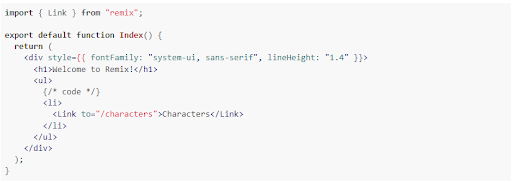
The ‘highlighted’ portion is what we will be adding. Keep in mind that when linking to the internal page, we must import the Link component from Remix. This is important because this way, Remix can preload the next route and help improve the app’s performance.
To make the route available, let's create a file characters.jsx in the routes.

Save this code and start the server by running ‘run, npm, dev’ and notice that the link works.
Step 2: List all Characters
Now let’s create the characters in the Lord of Rings series as cataloged by the API. The way React Remix adopts the load data into the route is called loaders. You can test them by adding a function called ‘loader’ in the route.
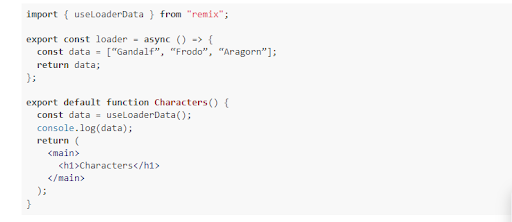
Add the highlighted portion and check how the data variable in the loader function becomes available in the useLoaderData a hook. This is mostly absent in other libraries- the actual component and the data source are coupled together.
Now, let's remove the dummy data and create the actual API. For that, have an API key and the base path set. Also, create .env document at the root and add the following information:
BASE_PATH="insert API base path"
API_KEY="insert an API key from https://the-one-api.dev/"
Once done, you will be able to use variables using process.env. Now, let’s go back to the loader function and see how the actual data is available on the route component.
Step3: Adding Nested Route:
Create the nested route if you want the character's details to be expanded by simply clicking on the names. And, since it’s a nested route, you need to create the route in the format /character/$id.
Now, get to the characters.jsx and link them.
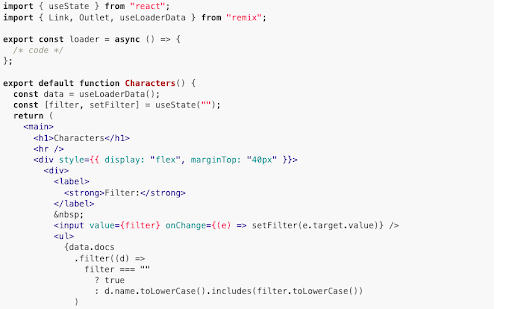
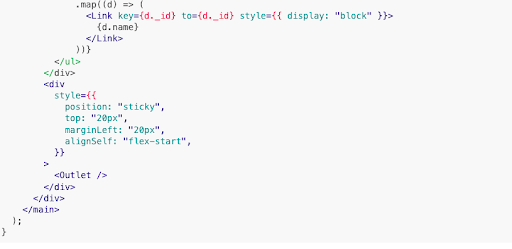
By this code, we have added a client-side filter to look at the specific character. You can also insert a Link component for every character, using the variable _id as an identifier. The Outlet component is what host the nested component.
You can interpret route chunks as variables by simply prefixing them with a $. Lets now create a new folder /app/routes/characters and put them in a file $id.jsx. Through this, Remix will understand that a route (/characters/abc) will show a variable called id whose value would be abc.
Now open $id.jsx and add the following code.
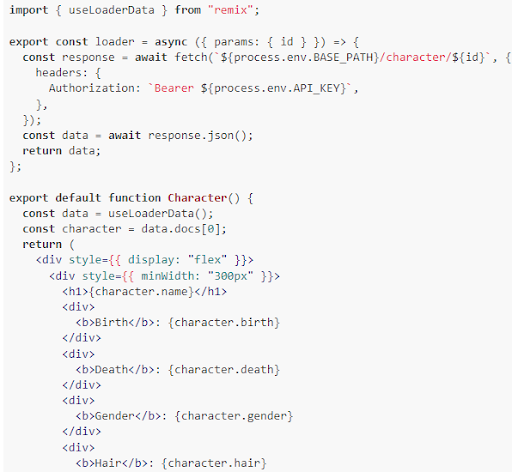
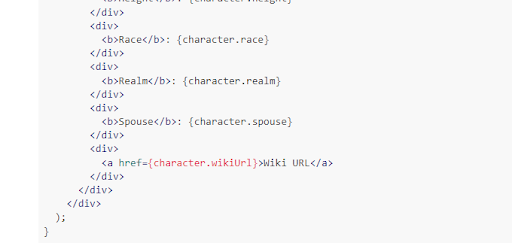
See how you have destructured (params: id) to get access to the id in the server. Then, you can use the API in the same way as you were doing previously and useLoaderData again to get access to the component. Keep in mind that the ‘wiki URL’ is the external link, so you don’t use the Link component but an old anchor tag.
Let's check: click on the character name, and it will instantly open the details; now see how hitting back in the browser changes the URL and the content. This is how nesting routes work from the Outlet component.
How Many Nestings Should You Do In A Code?
Let us evaluate this by adding another level of nesting. In this, you will create a link that will open the quotes of the specific character. The route will be /characters/123/quotes. Following the same method you did in the above nesting route, create a folder with the name of the parent route (app/routes/characters/$id) and in the file with the name of the desired route:
quotes.jsx.
open quotes.jsx and add the following code:
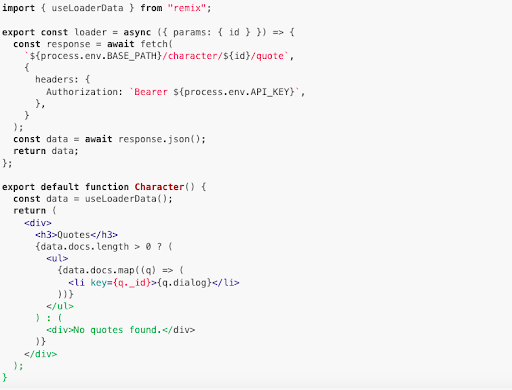
Go back to the $id.jsx and add the missing link;
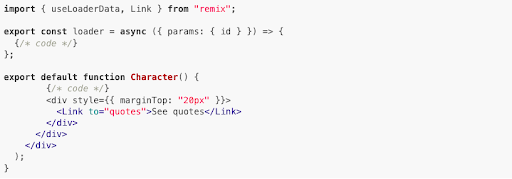
What happened? Nothing to see?
That happens because you use the Outlet component every time you make a nested route. And for this, a single Outlet component is not enough; you need one for every nested level.
Therefore you need to add another Outlet component, $id.jsx:
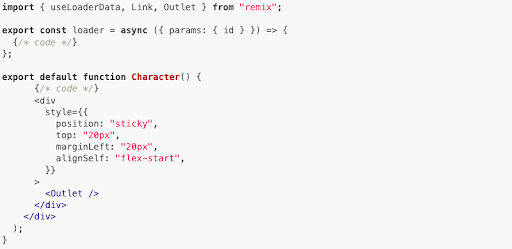
Output:
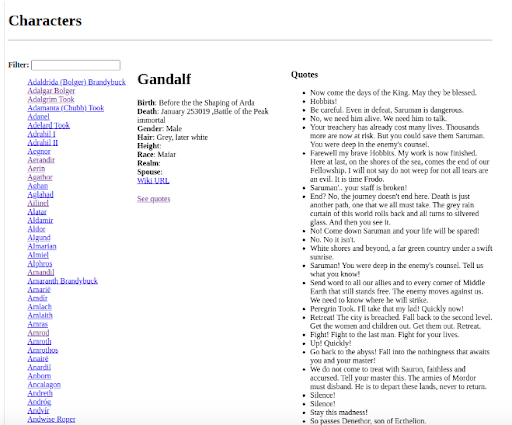
Step 4: Error Boundaries in Action:
The last thing you need to consider is Error Boundaries. In simple terms, if something happens in your app, the closest boundary would ‘intercept’ it and prevent the deeply nested mistake from crashing the whole application. So, if you are talking about the two-level nested route, it is important that you must prevent the issue in the quotes route.
Let’s add ErrorBoundary and test this function
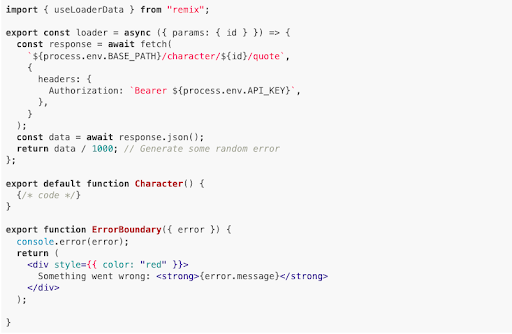
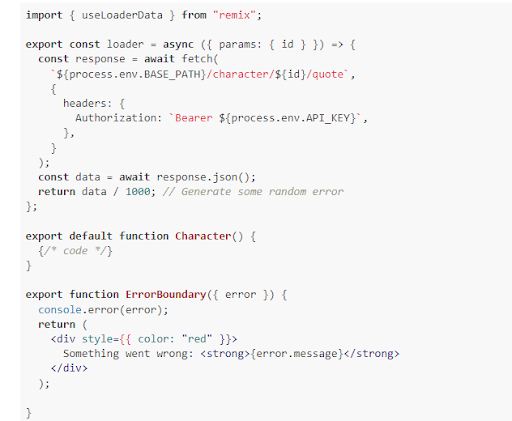
Presently, select a person, click on "See statements," and check how just the statements part is broken.
Conclusion
Respond Remix is an intriguing system and another worldview for current principles. It brings back some old web improvement standards, which are terrible in no way, shape, or form.
The innovation is genuinely new and depends upon future developments. Subsequently, I'd be wary of embracing this stack underway. In any case, keep an eye on the merits and see the progress.
Another fast thing to note is that being an SSR structure, Remix is certainly not an ideal decision for creating an application. This is because each page hit will ping the API in the future, with information that won't change frequently and consequently stress the API server pointlessly (in the danger of being rate-restricted). On the other hand, an SSG system like Gatsby or Next would presumably be a definitive decision.
Notwithstanding, this approach would work better if our information had been more powerful (a stock cost, for instance). Hence, understanding your application's business needs is critical when deciding if React Remix is sufficient for you.






